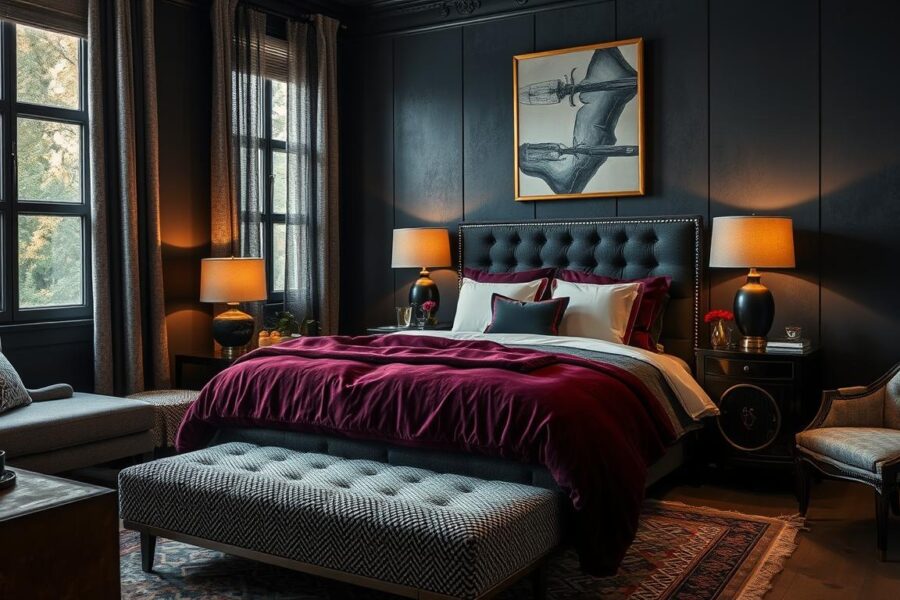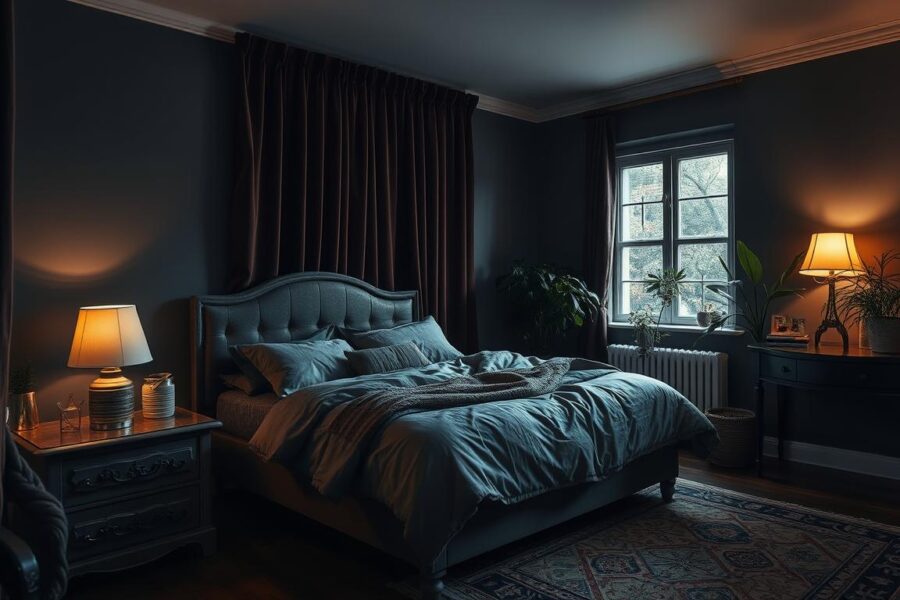This post contains affiliate links. Some images may have been created with the help of AI.
Struggling to find the right plants for your dimly lit bedroom? You’re in luck! These five plants are perfect for low-light spots. They make your bedroom cozy and refreshing1.
The ZZ plant and Peace Lily are not just pretty. They also clean the air in your room. Learn how these easy-to-care-for plants can turn your bedroom into a peaceful, lively space1.
Understanding Moody Bedroom Environments
Creating the perfect moody bedroom for plants is a challenge. It involves dealing with low light, changing humidity, and temperature. It’s a test of your green thumb skills2.
Light Conditions in Dark Spaces
Dark bedrooms lack natural light, making it hard for plants to thrive. But, with the right plants and creativity, you can create a lush space2.
Humidity and Temperature Factors
Moody bedrooms also have issues with humidity and temperature. These changes can harm your plants. Finding the right balance is key to their health2.
Creating the Perfect Plant Environment
To make a perfect plant space, think about light, humidity, and temperature. Place plants wisely, use artificial light, and keep conditions steady. This way, you can have a thriving oasis even in dark rooms2.
With the right knowledge and some trial and error, you can turn your dark bedroom into a lush haven. It will show off the beauty of tough, adaptable plants3.
Benefits of Plants in Dark Bedrooms
Adding plants to dark bedrooms offers many benefits. They can improve air quality and boost mood and well-being4. Even though only a few plants do well in low light, their benefits are significant.
One key advantage is air purification. Plants like the Peace Lily and Snake Plant remove harmful toxins. They also increase oxygen levels5. This can help your breathing and make your sleep area fresher.
Plants also help with mental health. Being near nature, even in a bedroom, can lower stress and anxiety. It can also improve focus and productivity. The calming effect of plants can help you sleep better and feel more refreshed.
“Incorporating plants into your bedroom can be a simple yet effective way to enhance the ambiance and improve your overall well-being.”
While some plants can survive in low light, they won’t grow well or look healthy4. Choosing plants like the ZZ Plant, Peace Lily, and Snake Plant can bring benefits without much work.
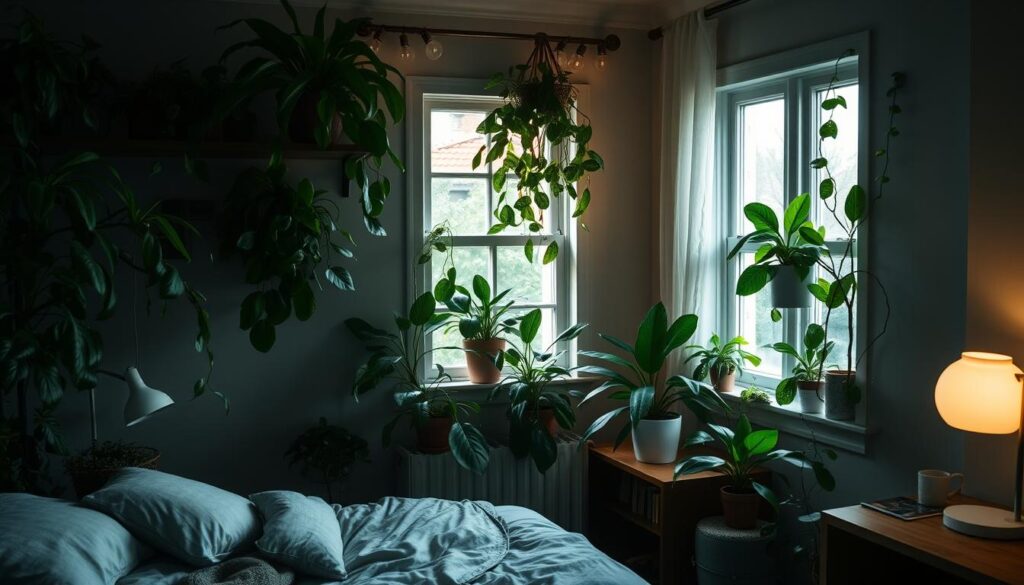
Plants in dark bedrooms offer more than just air purification and mood boosts. They also add natural beauty to the space45. By picking and caring for the right plants, you can turn a dark bedroom into a peaceful retreat. This can lead to better sleep and overall health.
ZZ Plant: The Ultimate Low-Light Survivor
The ZZ Plant (Zamioculcas zamiifolia) is perfect for dimly lit bedrooms. It thrives in low light, making it great for shaded corners and even windowless spaces6.
Care Requirements for ZZ Plants
The ZZ Plant is easy to care for. Its waxy leaves and water-storing rhizomes mean it needs little water6. It can go weeks or even months without a drink. Water it every 2-3 weeks, letting the soil dry out completely between waterings6.
It prefers well-draining soil, like a cactus or succulent mix6.
Placement and Maintenance Tips
The ZZ Plant loves low light, making it perfect for dim corners6. It looks elegant and modern, adding style to any room6. Watch out for yellow leaves (overwatering) or brown tips (underwatering or low humidity)6.
Varieties and Options
There’s more than just the classic green-leafed ZZ Plant. The ZZ Raven has dark foliage for a moody look6. No matter the variety, the ZZ Plant is low-maintenance and tough. It’s a great choice for anyone wanting to bring nature indoors.
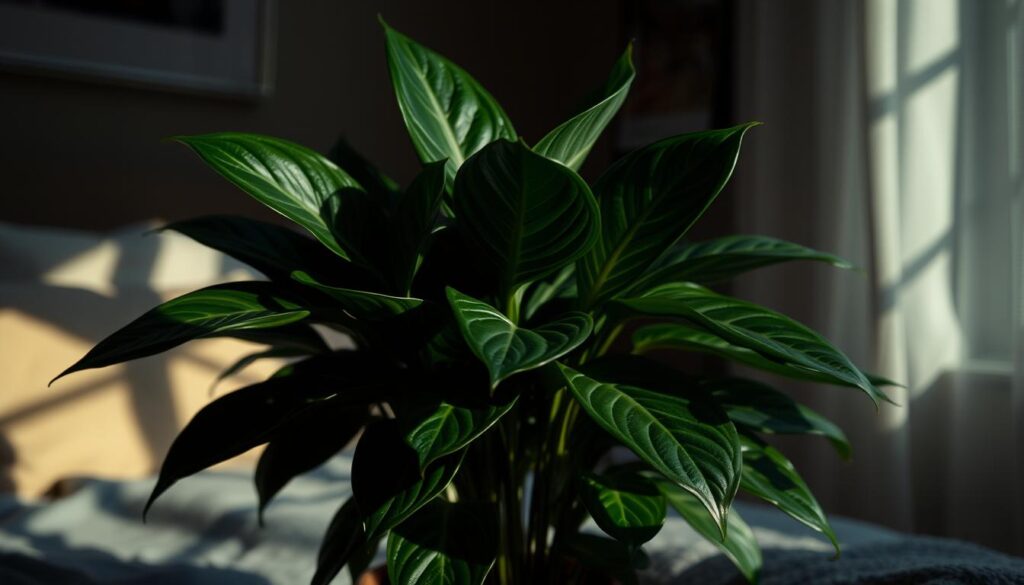
Peace Lily: Elegant Shadow Dweller
The Peace Lily, also known as Spathiphyllum, is a great choice for dark rooms. It’s good at cleaning the air and looks beautiful with its white flowers and shiny leaves7.
This plant can bloom even in dim light, which is rare for indoor plants7. It’s perfect for places with little sunlight, like bathrooms and bedrooms. It brings a calm and peaceful vibe to these areas.
The Peace Lily is also known for purifying the air. It’s among the top 10 plants for cleaning indoor air7. Plus, it grows well under artificial lights, making it easy to care for in many spaces7.
To keep the Peace Lily healthy, it needs the right care. It needs proper watering, humidity, and occasional food. With the right care, it can be a beautiful addition to your bedroom for a long time.
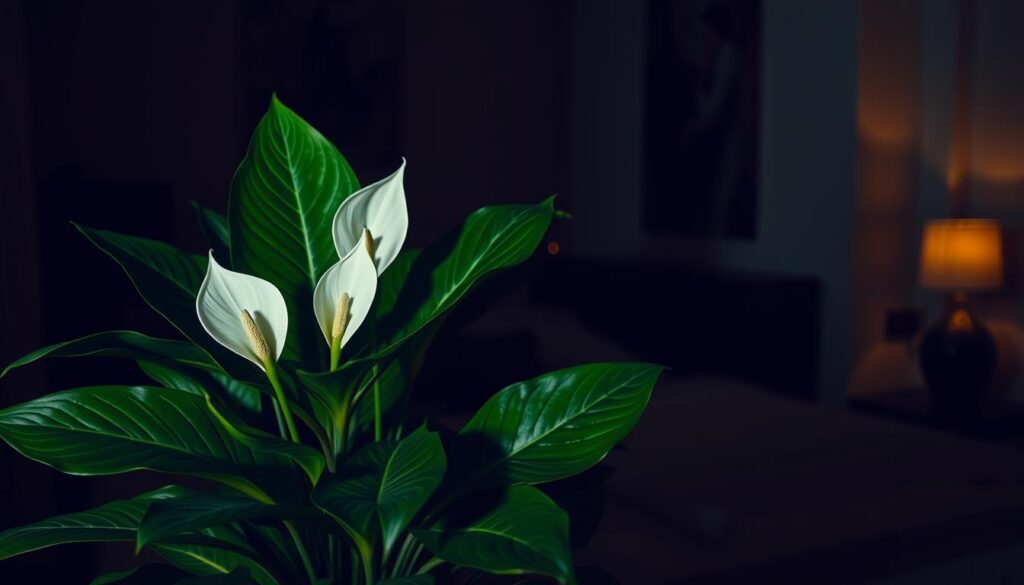
Remember, the Peace Lily can be harmful to people and pets7. Make sure it’s out of reach of kids and pets to keep everyone safe.
Low Light Indoor Plants: Essential Care Guide
Indoor plants can brighten up any room, even in dim spaces. While most houseplants need bright light, some can handle low light well. These plants can make your moody bedrooms and shady corners lively8. Knowing how to care for them is crucial for their health.
Watering Schedules
Watering low-light plants requires a gentle touch. Too much water can cause root rot. Let the soil dry a bit before watering again. Adjust this based on the plant’s needs. Plants like ZZ Plant8 and Snake Plant8 can even survive with a bit of drought.
Fertilization Requirements
Low-light plants need less food than those that get lots of sun. Use a balanced, diluted fertilizer every 4-6 weeks when they’re growing. Don’t overdo it, as this can harm your plants.
Common Care Mistakes
Even low-light plants can suffer from common mistakes. Too much water, poor drainage, and not enough light can harm them. Watch for signs like wilting, yellow leaves, or slow growth. Adjust your care if you see these signs.
With proper care, low-light plants can flourish in tough spots. From the ZZ Plant8 to the elegant Peace Lily, there’s a wide range to choose from. Let these plants add beauty and benefits to your home.
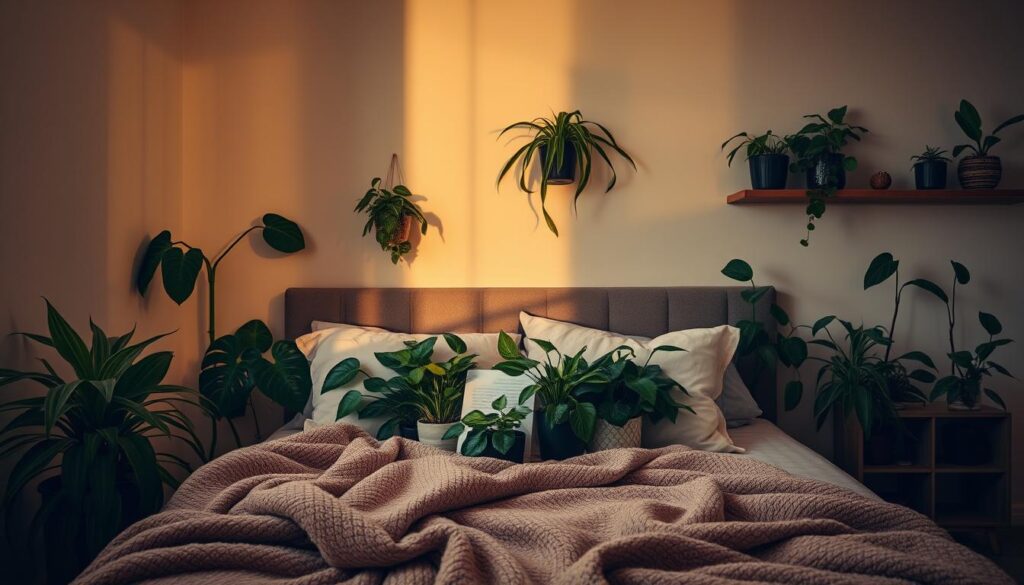
Snake Plant: The Bedroom Air Purifier
The Snake Plant, also known as Sansevieria, is a great choice for dark bedrooms. It has striking vertical leaves and purifies the air. This plant is perfect for any low-light space9.
Snake plants are known for removing toxins like formaldehyde and benzene from the air910. NASA’s 1989 study named them as top air-purifying plants10. They release a lot of oxygen at night, helping with sleep and breathing10.
Snake plants are ideal for dark bedrooms because they’re easy to care for. They only need watering every 2-6 weeks10. They also do well in indirect sunlight, needing just 5-6 hours a day10. Plus, they’re hard to kill, making them great for beginners10.
There are many snake plant varieties to choose from. The ‘Laurentii’ has yellow-edged leaves, while ‘Futura Superba’ is compact. ‘Twisted Sister’ is tall and spiky9.
Even though snake plants are easy to care for, they can be toxic to pets. They can cause mouth and digestive problems if eaten10. With the right care, they can make any bedroom a healthier, calmer space.
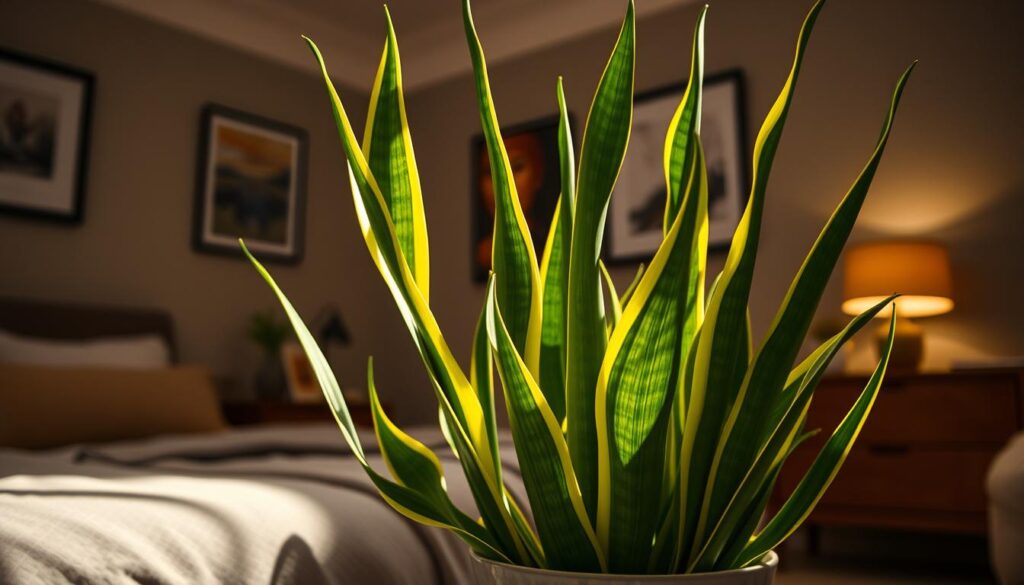
Best Plant Placement Strategies for Dark Rooms
Setting up plants in a dark bedroom is a fun challenge. The trick is to think about the light and place plants where they get the most of it. This makes your room feel lush and welcoming.
Window Proximity Guidelines
Start by putting plants near windows. Place tall plants like ZZ plants11, Kentia Palms12, and Rubber Plants11 by the windows for lots of indirect light. For smaller plants, like Peace Lilies11, Prayer Plants11, and Peperomia12, put them in front or beside the windows.
Creative Display Solutions
In dark spots, think outside the box with your plant displays. Use mirrors to make the room seem brighter. Vertical gardening, like hanging planters or stands, brings greenery without taking up space.12 Use corner shelves or wall-mounted holders for plants that love low light, like Maidenhair Ferns11, Snake Plants11, and English Ivy12.
With smart plant placement and creative displays, you can turn a dark bedroom into a peaceful green space. The secret is knowing what light your plants need and arranging them right.
Spider Plant: The Adaptable Classic
The Spider Plant (Chlorophytum comosum) is a favorite in many homes. It’s known for being easy to care for and can thrive in low light13. These plants are great at cleaning the air, removing harmful chemicals like formaldehyde and benzene13. Their long, ribbon-like leaves and plantlets add beauty to any room.
Spider Plants like temperatures between 60-75°F (15-24°C)13. They can handle cooler temperatures, but not below 50°F (10°C)13. They grow well in pots, hanging baskets, or as ground cover13. Plus, they’re easy to spread by creating new plants from offsets.
These plants need medium to bright indirect sunlight13. Direct sunlight can burn their leaves. They can grow up to 36″ tall and 20″ wide, making them great for shelves or hanging baskets13. Repotting every 2-3 years helps them grow, and feeding them in spring and summer keeps them healthy13.
It’s key to not overwater Spider Plants to avoid pests and diseases13. They can handle different humidity levels, making them perfect for moody bedrooms13.
Spider Plants are a classic choice for any room. They add a natural touch and clean the air in dark, moody bedrooms13.
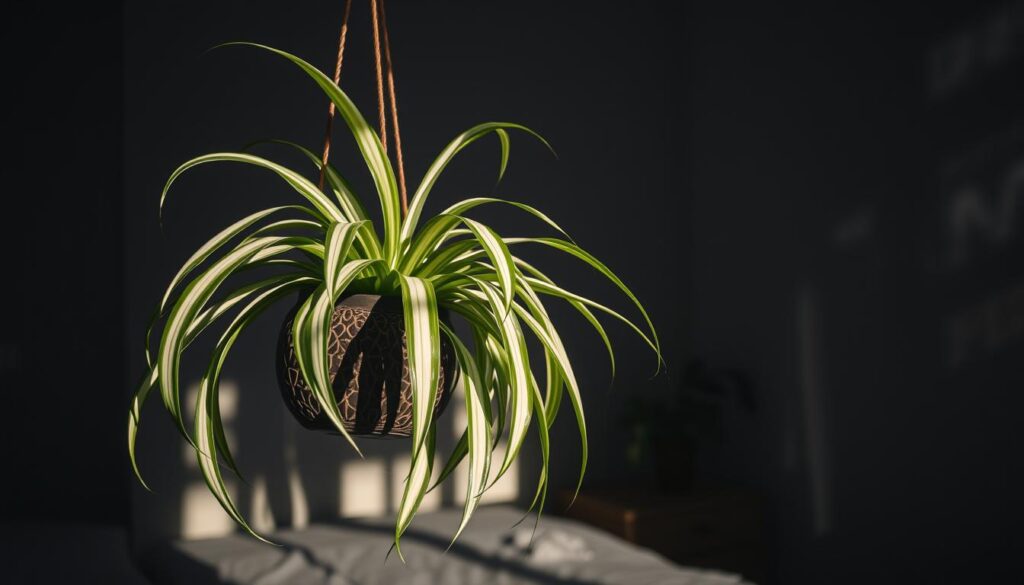
Maintaining Plant Health in Low Light Conditions
Keeping plants healthy in low light is a delicate task. But, with the right care, your indoor plants can thrive14. Plants like ZZ plants, peace lilies, and snake plants do well in dim spaces. They need special care to stay healthy and look good15.
Proper cleaning is key for low-light plants. Use a damp cloth to wipe leaves and remove dust. This helps them get more light15. Also, rotate your plants every few weeks. This ensures they grow evenly and don’t become lopsided14.
It’s important to watch for pests and diseases in low light. These plants can get spider mites, mealybugs, and root rot15. Quick action and the right treatments can keep your plants healthy.
Supplemental lighting is crucial for low-light plants. It gives them the extra light they need to grow14. Make sure the light is at the right distance and spectrum. Too much or too little light can harm them14. Keeping humidity levels right is also key for many low-light plants. Use a pebble tray or mist them now and then to meet their needs.
By following these tips, you can help your low-light plants thrive. They’ll add a touch of nature and greenery to your bedroom15.
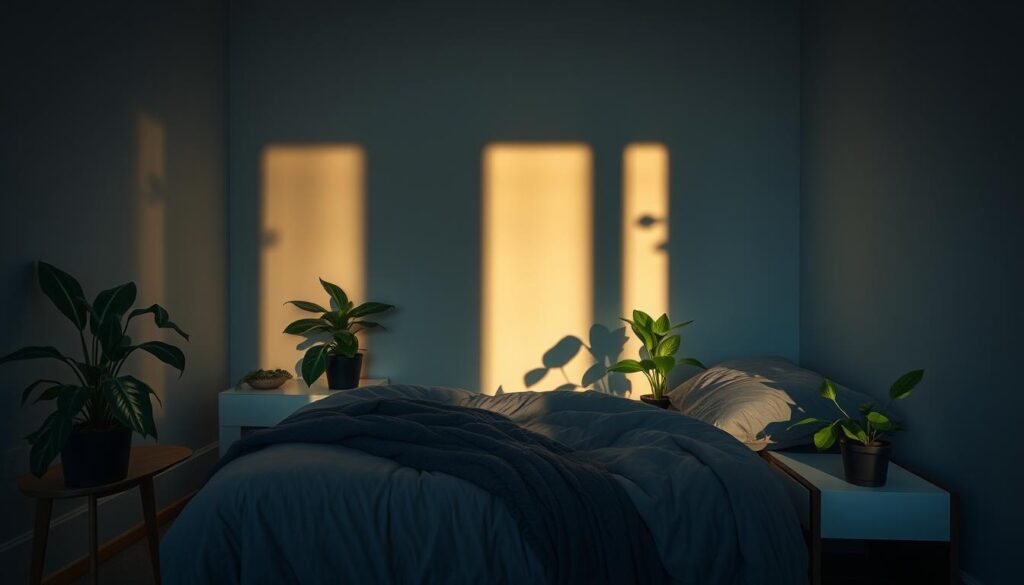
| Plant Type | Light Requirement | Watering Needs | Maintenance Level |
|---|---|---|---|
| ZZ Plant | Bright indirect to low light | Water every 2-3 weeks | Low maintenance |
| Peace Lily | Bright indirect to low light | Water when soil is dry | Moderate maintenance |
| Snake Plant | Bright indirect to low light | Water every 3-4 weeks | Low maintenance |
By following these guidelines and addressing any issues quickly, you can keep your low-light plants healthy. They’ll add natural beauty to your bedroom oasis15.
Styling Tips for Moody Bedroom Plants
Adding plants to your bedroom can change the game. They bring lush foliage and calm vibes. Think about the right containers and how to arrange them for a stunning look.
Container Selection
The right container can make a big difference. Choose materials and colors that match your dark, moody space. Go for matte black, deep green, or terracotta pots for a harmonious feel. Textured ceramics or sleek metal planters add sophistication.16
Arrangement Ideas
Grouping plants can make a bold statement. Mix different heights and sizes for interest. Hanging planters are great for adding height and saving space16.
Placing plants on nightstands or in bookshelves makes them part of the room’s design.
| Container Material | Color | Benefits |
|---|---|---|
| Matte Black | Dark and Moody | Complements the room’s color palette and creates a cohesive look. |
| Terracotta | Earthy Tones | Adds warmth and natural texture to the space. |
| Textured Ceramics | Varied Hues | Introduces visual interest and a tactile element to the decor. |
Choosing the right containers and arranging plants well can make your bedroom a peaceful oasis16.
Conclusion
Adding low light indoor plants to your moody bedroom can make it a peaceful, nature-filled space. Plants like the Snake Plant17 clean the air and the ZZ Plant1817 is tough and easy to care for. These plants are perfect for dark rooms1819.
Placing plants wisely can make your moody bedroom look better and feel fresher. It can also lift your mood and make your home a calm retreat19. Choose plants like the Peacock Plant18 or the elegant Peace Lily17 based on your taste and room light1817.
Start making your moody bedroom a green oasis. Try out different plants and where to put them. With the right low light indoor plants, you can create a peaceful spot that refreshes you181917.

